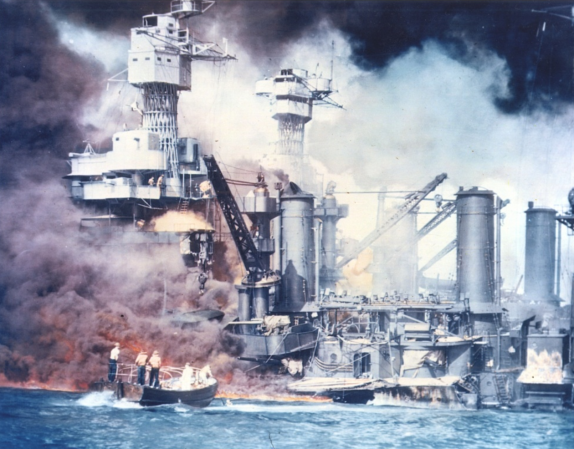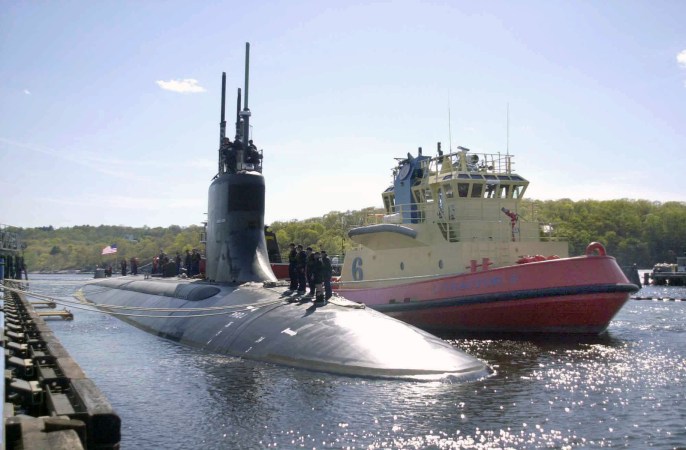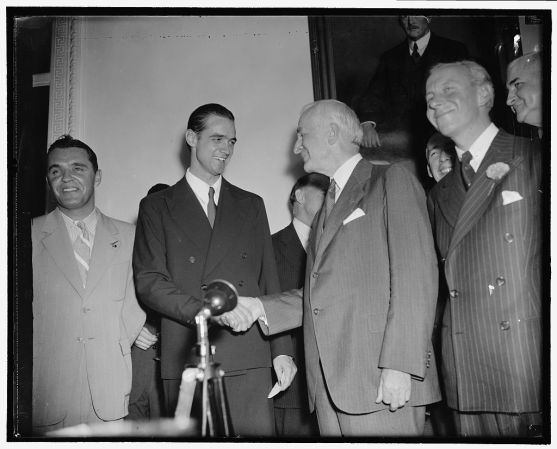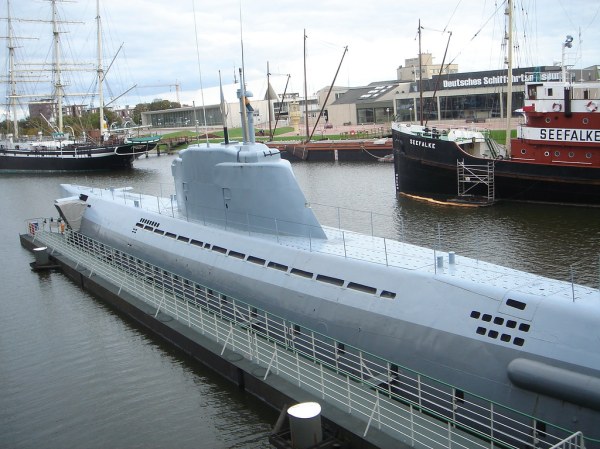Ah, football. Nothing’s sweeter than getting everyone together to drink beer, eat hot dogs, watch sports, and look at corporate slogans painted on a 250-foot weapon of war that floats over them just like it floated over Nazi and Japanese submarines before bombing them into Davy Jones’ depths.
Yeah, that’s right — the Goodyear Blimp used to be a bona fide badass.

A K-class blimp flies during convoy escort duty.
(National Museum of Naval Aviation)
See, during World War II, America actually still had a pretty robust blimp program. While the rest of the world pretty much abandoned airships after the Hindenburg disaster, the U.S. was able to press forward since it had the bulk of the world’s accessible helium.
And press forward it did. While the more ambitious projects, like experimental, flying aircraft carriers, were shelved in the 1930s, America had 10 operating blimps in the U.S. Navy when Pearl Harbor was attacked, and they were quickly sent to patrol the U.S. coasts, watching for submarines.
The K-class blimps were 250-foot long sacks of helium that carried a control car with the crew inside. A fully staffed crew was 10 men, which included a pilot, gunners, and anti-submarine warriors.

Crew members load one of the four depth charges onto a K-class blimp.
(National Museum of Naval Aviation)
Yeah, blimps were there to kills subs. The K-class blimps, which accounted for 40 percent of the pre-war fleet and over 80 percent of airships built during the war, usually sported a .50-cal. or two for self-defense and four 350-pound depth charges. They could also be used to lay mines and carry cargo more quickly than their sea-bound brethren and could deploy paratroopers. In fact, the Marine Corps parachute schools in World War II included jumping out of blimps in Lakehurst, New Jersey.
The ability to spot and attack submarines while able to fly out of attack range made airships valuable on convoy duty, where they would hunt enemy subs and report the locations to escort ships. When appropriate, they’d drop their own depth charges against the subs, but re-arming required landing on a carrier, so it was best to not waste limited ammo.

A crew member checks his .50-cal. machine gun during operations.
(National Museum of Naval Aviation)
One of the airships’ most famous battles came on the coast of Florida when the K-74 spotted a German sub bearing down on two merchant ships during the night of July 18,1943. There were typically somewhere around 10 German subs off the coast of the U.S. at any time, but the War Department and Navy Department at the time tried to keep it quiet.
K-74 attempted a surprise attack, dropping depth charges right onto the sub from 250 feet in the air, interrupting its attack and saving the merchant ships. Unfortunately, the submarine crew spotted the attacking airship and lit the low-flying vessel up with the sub’s anti-aircraft guns while the airship dropped two depth charges.

A blimp crashes during a nuclear test. Four K-class blimps were destroyed this way in the late 1950s.
(U.S. Department of Energy)
The consequences were immediate and severe for the blimp. The air envelope was severely damaged and set on fire by the German guns. The crew was able to extinguish the fire, but they could not maintain altitude and slowly settled into the sea. The commander stayed behind to dump classified gear and documents while the rest of the crew escaped in lifejackets.
The commander was separated from his men and rescued the next morning when he was luckily spotted by the crew of another airship.
The crew, all nine of them, climbed onto the airship envelope which floated in the water, and they were spotted the next morning as well. Unfortunately, a shark found them between when they were spotted by a sea plane and when a ship was able to rescue them. The shark attacked and killed one crew member, but the other eight escaped and survived.
It marked the only time an airship was destroyed by enemy fire. As for the submarine, it had received damage from the depth charge attack and was damaged again by a U.S. plane while escaping the east coast. It was forced to stay on the surface of the water en route to Germany for repairs and was spotted by British planes. Bombing runs by the Brits sealed its fate.
Airships were rarely allowed to directly attack submarines, and the attack by K-74 is one of the only documented times an airship directly damaged an enemy sub. In April 1945, K-72 dropped the newest weapon in its arsenal, an acoustic torpedo, into the water against German sub U-879. A destroyer documents a clear underwater explosion but no debris or wreckage was recovered and, so, no kill was awarded.

An airship crew distributes life jackets while operating over the water.
(National Museum of Naval Aviation)
But the airships were valued anti-submarine tools, often called into hunts to maintain contact with enemy subs as surface vessels danced around to avoid torpedoes.
In fact, two blimps were involved in a disputed submarine battle claimed by L. Ron Hubbard, the founder of Scientology and a Navy veteran. Hubbard and his crew of PC-815 claimed the destruction of two submarines in a May 1942 engagement where PC-815 dropped its own depth charges while calling for reinforcement. Two Navy blimps, K-39 and K-33, responded and assisted in the search.
Hubbard would later claim one sub killed and the other too damaged to return to port, but the crews of the other vessels disputed the claim and Hubbard did not collect any physical evidence of his kill.

Blimps served a number of functions off the coast of Europe, mostly convoy duty, mine sweeping, and cargo carrying.
The airships also engaged in less glamorous work, moving supplies and troops from position to position, out of range of enemy subs but vulnerable to air attack. They were sometimes used for fast trips across the ocean or for ferrying freight from England to other allied outposts like the Rock of Gibraltar.
Some arguments were made that the airships were one of the best options for minesweeping. They were used heavily for this activity off the coasts of Europe where the airships flew over the water, cataloging mine locations and reporting them to surface vessels which could avoid the fields until the Navy was ready to remove them.

Four K-Class blimps were tested near nuclear blasts to see how they stood up to the over pressurization from the atomic blast. They didn’t fare well.
(U.S. Department of Energy)
In one high-profile mission, airships were tasked with protecting President Franklin Roosevelt’s and Prime Minister Winston Churchill’s convoy to the Yalta Conference in 1945.
After the war, the over 150 airships in the fleet were slowly decommissioned and either retired or sent for other uses. Goodyear used one of the K-class in its commercial fleet, but it proved less than cost effective and was retired in just a year. Four airships were destroyed in nuclear tests and the last airship was retired in March 1959.


























